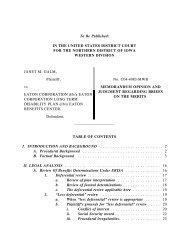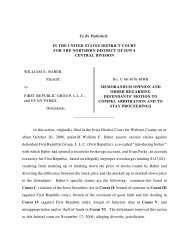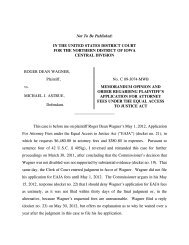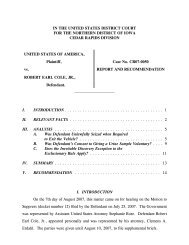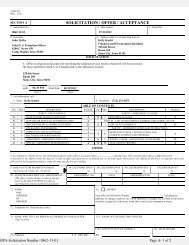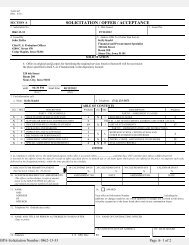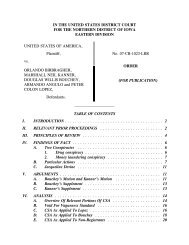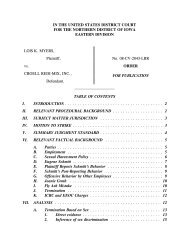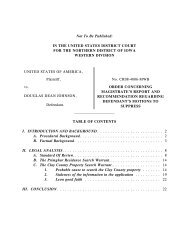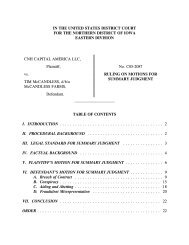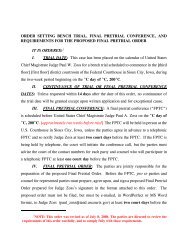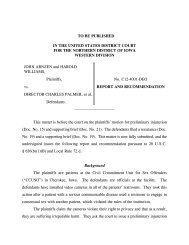Shannon v. Koehler - Northern District of Iowa
Shannon v. Koehler - Northern District of Iowa
Shannon v. Koehler - Northern District of Iowa
Create successful ePaper yourself
Turn your PDF publications into a flip-book with our unique Google optimized e-Paper software.
elevant is not admissible.” FED. R. EVID. 402. Rule 403 provides for exclusion <strong>of</strong> even<br />
relevant evidence on various grounds, as follows:<br />
Although relevant, evidence may be excluded if its probative<br />
value is substantially outweighed by the danger <strong>of</strong> unfair<br />
prejudice, confusion <strong>of</strong> the issues, or misleading the jury, or<br />
by considerations <strong>of</strong> undue delay, waste <strong>of</strong> time, or needless<br />
presentation <strong>of</strong> cumulative evidence.<br />
FED. R. EVID. 403. The Eighth Circuit Court <strong>of</strong> Appeals has explained “prejudice” within<br />
the meaning <strong>of</strong> Rule 403 as follows:<br />
Under Rule 403, district courts have broad discretion to assess<br />
unfair prejudice, and are reversed only for an abuse <strong>of</strong><br />
discretion. United States v. Henderson, 416 F.3d 686, 693<br />
(8th Cir. 2005), cert. denied, 546 U.S. 1175 (2006). Rule 403<br />
“does not <strong>of</strong>fer protection against evidence that is merely<br />
prejudicial in the sense <strong>of</strong> being detrimental to a party’s case.<br />
The rule protects against evidence that is unfairly prejudicial,<br />
that is, if it tends to suggest decision on an improper basis.”<br />
Wade v. Haynes, 663 F.2d 778, 783 (8th Cir. 1981), aff’d sub<br />
nom. Smith v. Wade, 461 U.S. 30, 103 (1983).<br />
United States v. Myers, 503 F.3d 676, 682 (8th Cir. 2007); accord United States v.<br />
Farrington, 499 F.3d 854, 858-59 (8th Cir. 2007). The Advisory Committee Notes to<br />
Rule 403 explain that a decision on an “improper basis” is “commonly, though not<br />
necessarily, an emotional one.” FED. R. EVID. 403, Advisory Committee Notes; see also<br />
United States v. Jiminez, 487 F.3d 1140, 1145 (8th Cir. 2007) (quoting this note); United<br />
States v. Dierling, 131 F.3d 722, 730-31 (8th Cir. 1997) (considering whether evidence<br />
was unfairly prejudicial, because it might lead to a decision on an improper basis, where<br />
it revealed grisly or violent behavior that made the defendant appear dangerous). Unfairly<br />
prejudicial evidence has also been described as evidence that is “‘so inflammatory on [its]<br />
face as to divert the jury’s attention from the material issues in the trial.’” United States<br />
15



